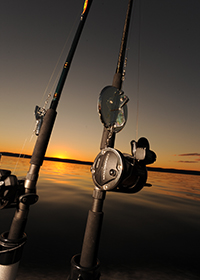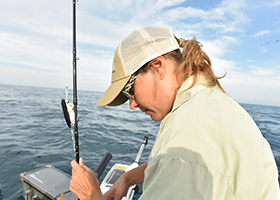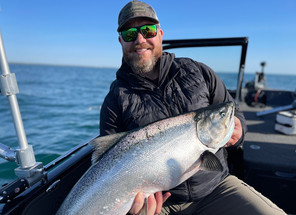Posted by Chris Larsen on 1st Jun 2023
How To Fish With A Dipsy Diver
 Dipsy Divers are a great way to get your trolling lines into deep water without the use of downriggers or long lines. Often called “dipsies,” many new trollers use them in place of downriggers but even experienced anglers will use dipsy divers as a vital part of their trolling program.
Dipsy Divers are a great way to get your trolling lines into deep water without the use of downriggers or long lines. Often called “dipsies,” many new trollers use them in place of downriggers but even experienced anglers will use dipsy divers as a vital part of their trolling program.
Ross Robertson from Bigwater Fishing on Lake Erie describes Dipsy Divers as “underwater planer boards”. By using the adjustment mechanism on the diver, you can control both the depth and how far out from the boat the diver travels when deployed. There is a trip mechanism that breaks free when you get a bite so you’re only fighting the fish and not the diver.
How Do You Use A Dipsy Diver For Trolling?
Setup: Start by attaching the Dipsy Diver to your fishing line. Many advanced anglers will use wire lines. But beginning trollers will often use braid on their dipsy rods. Braid is a little easier to work with and won’t have the line stretch found with monofilament. The Dipsy Diver typically has a swivel on one end and a clip on the other. Attach the swivel end to your main fishing line using a strong knot like a clinch knot or a loop knot.
Leader Length: Determine the length of the leader you want between the Dipsy Diver and your lure. This length can vary depending on the fishing conditions and the depth at which you want to fish. A common range is around 3 to 6 feet, but you can adjust it if conditions are necessary. Many anglers will use a longer leader in clearer water or with crawler harnesses. However, it is a little trickier landing a fish as the leader gets longer since you can’t reel past where the dipsy diver is on your line.

Attach the Lure: It’s a good idea to use a snap swivel on the back of the Dipsy Diver as well. That way you don’t have to cut leaders every time you want to make a change to your presentation. Tie the end of your leader to your fishing lure using a secure knot. Popular choices for lures include spoons, plugs, or bait such as herring or smelt. A tight and secure knot will help prevent lost fish.
Adjusting the Dipsy Diver: The Dipsy Diver has an adjustable mechanism that controls the diving depth and direction. There are usually three settings: left, center, and right. Adjust the trip mechanism based on your desired diving depth and the direction you want the Dipsy Diver to pull your lure. Obviously, the more line you let out, the deeper the diver will run. The speed of your troll will also affect depth.
Deployment: When lowering the Dipsy Diver, be sure to have the clicker of your line counter reel on or have the reel in your hand when dropping the line down. If you lower it too fast, the leader and lure could end up tangled in the diver. A sturdy rod holder is necessary. When a salmon, trout, or steelhead hit the lure, you could lose a rod with a poorly built rod holder. The rod should be low and the tip should be pointed down near the surface of the water.
Reeling In: If you see the rod tip surging, there’s a good chance you have a fish on. When you want to retrieve your line, reel in the line while keeping tension. The person with the rod in their hand will most likely need to take a few steps back so the fish can be brought close enough to the boat to net it.
Want a different option? Click here to check out our podcast on Slide Divers.

